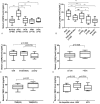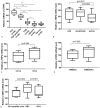Expression and clinical significance of latent-transforming growth factor beta-binding protein 2 in primary hepatocellular carcinoma
- PMID: 31574831
- PMCID: PMC6775391
- DOI: 10.1097/MD.0000000000017216
Expression and clinical significance of latent-transforming growth factor beta-binding protein 2 in primary hepatocellular carcinoma
Abstract
The present study aimed to explore the expression of latent transforming growth factor β binding protein 2 (LTBP2) in patients with hepatocellular carcinoma (HCC) and their correlation to clinicopathologial features.Serum levels of LTBP2 in 60 patients with HCC, 35 patients with hepatocellular benign tumors, 60 patients with precancerous lesions of HCC, and 60 healthy volunteers were determined by enzyme-linked immunosorbent assay. The expression levels of LTBP2 at messenger RNA (mRNA) and protein levels in 60 cases of HCC and adjacent tissues were detected by quantitative real-time polymerase chain reaction and immunohisochemistry. Statistical analysis was used to analyze the relationship between LTBP2 and clinical characteristics of patients with HCC.The mRNA and protein levels of LTBP2 were significantly upregulated in HCC tissues compared to adjacent tissues. Additionally, higher serum LTBP2 level was also observed in HCC patients relative to normal controls. Further investigation demonstrated that LTBP2 expression was associated with malignant degree of tumor, tumor progression, tumor differentiation, tumor size, tumor stage and hepatitis virus infection, and has prognostic implications in HCC patients.LTBP2 might be served as a potential biomarker in diagnosis and treatment of HCC.
Conflict of interest statement
The authors have no conflicts of interest to disclose.
Figures



Similar articles
-
Latent Transforming Growth Factor β Binding Protein 2 (LTBP2) as a Novel Biomarker for the Diagnosis and Prognosis of Pancreatic Carcinoma.Med Sci Monit. 2017 Jul 3;23:3232-3239. doi: 10.12659/msm.905284. Med Sci Monit. 2017. PMID: 28669978 Free PMC article.
-
High Expression of LTBP2 Contributes to Poor Prognosis in Colorectal Cancer Patients and Correlates with the Mesenchymal Colorectal Cancer Subtype.Dis Markers. 2019 Mar 10;2019:5231269. doi: 10.1155/2019/5231269. eCollection 2019. Dis Markers. 2019. PMID: 30956730 Free PMC article.
-
Transforming growth factor-β1 gene expression in hepatocellular carcinoma: a preliminary report.Arab J Gastroenterol. 2014 Sep-Dec;15(3-4):142-7. doi: 10.1016/j.ajg.2014.10.007. Epub 2014 Dec 2. Arab J Gastroenterol. 2014. PMID: 25475758
-
The gene expression level of transforming growth factor-beta (TGF-beta) as a biological prognostic marker of hepatocellular carcinoma.J Exp Clin Cancer Res. 2005 Sep;24(3):415-21. J Exp Clin Cancer Res. 2005. PMID: 16270528
-
The prognostic significance of LTBP2 for malignant tumors: Evidence based on 11 observational studies.Medicine (Baltimore). 2022 Apr 29;101(17):e29207. doi: 10.1097/MD.0000000000029207. Medicine (Baltimore). 2022. PMID: 35512078 Free PMC article.
Cited by
-
Transforming growth factor β latency: A mechanism of cytokine storage and signalling regulation in liver homeostasis and disease.JHEP Rep. 2021 Nov 18;4(2):100397. doi: 10.1016/j.jhepr.2021.100397. eCollection 2022 Feb. JHEP Rep. 2021. PMID: 35059619 Free PMC article. Review.
-
Machine Learning Identifies Key Proteins in Primary Sclerosing Cholangitis Progression and Links High CCL24 to Cirrhosis.Int J Mol Sci. 2024 May 30;25(11):6042. doi: 10.3390/ijms25116042. Int J Mol Sci. 2024. PMID: 38892228 Free PMC article.
-
Transcriptomic Cross-Species Analysis of Chronic Liver Disease Reveals Consistent Regulation Between Humans and Mice.Hepatol Commun. 2022 Jan;6(1):161-177. doi: 10.1002/hep4.1797. Epub 2021 Aug 28. Hepatol Commun. 2022. PMID: 34558834 Free PMC article.
References
MeSH terms
Substances
LinkOut - more resources
Full Text Sources
Medical
Miscellaneous

